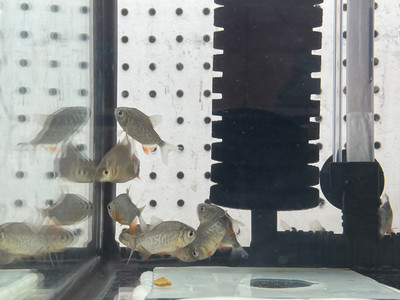Pacu
Posted by Max Gandara on on 17th Jul 2024
The Fascinating World of Pacu Fish: A Guide for Enthusiasts
If you're an aquarium enthusiast looking for a unique and captivating addition to your tank, the Pacu fish might be just what you're looking for. Known for their distinctive appearance and fascinating behavior, Pacu fish are a favorite among many aquarists. In this blog, we'll dive into the world of Pacu, exploring their origins, care requirements, and some interesting facts that make them stand out.
What Are Pacu Fish?
Pacu fish belong to the family Serrasalmidae, which also includes their infamous relatives, the piranhas. Native to the freshwater rivers and lakes of South America, particularly the Amazon and Orinoco river basins, Pacu fish are often mistaken for piranhas due to their similar body shape. However, unlike their carnivorous cousins, Pacu are primarily herbivores, feeding on a diet of fruits, nuts, and plants.
Appearance
One of the most striking features of Pacu fish is their impressive size. They can grow up to 3 feet in length and weigh as much as 55 pounds in the wild. In captivity, they typically reach about 12 to 24 inches, depending on the size of the tank and the care they receive. Pacu have a deep, laterally compressed body with a blunt head and strong jaws. Their teeth are surprisingly human-like, which they use to crush and grind their food.
Types of Pacu Fish
There are several species of Pacu, but the most common ones found in the aquarium trade are:
- Red-Bellied Pacu (Piaractus brachypomus): Known for its distinctive red belly, this species is a popular choice for home aquariums. They can grow quite large, so a spacious tank is necessary.
- Black Pacu (Colossoma macropomum): Also known as the Giant Pacu, this species is the largest of the Pacu family. They are typically black or dark grey and require even larger tanks due to their size.
- Silver Pacu (Mylossoma duriventre): Smaller than the Red-Bellied and Black Pacu, the Silver Pacu is still a sizable fish and has a silvery sheen to its scales.
Tank Requirements
Caring for Pacu fish can be rewarding, but it requires a commitment to providing the right environment. Here are some key tank requirements for Pacu fish:
- Tank Size: Due to their large size, Pacu fish need a spacious tank. A minimum of 150 gallons is recommended for a single fish, with an additional 50-75 gallons for each additional fish.
- Water Conditions: Pacu fish thrive in warm, slightly acidic to neutral water. Maintain a temperature of 75-82°F, a pH of 6.5-7.5, and a hardness of 2-15 dGH.
- Filtration: Pacu produce a significant amount of waste, so a robust filtration system is essential to maintain water quality. Regular water changes are also necessary.
- Diet: While Pacu are primarily herbivores, they are opportunistic feeders and will eat a variety of foods. Offer a balanced diet of vegetables (such as spinach, peas, and zucchini), fruits (such as apples and grapes), and commercial pellets. Occasionally, you can supplement their diet with protein sources like insects and small fish.
Behavior and Compatibility
Pacu fish are generally peaceful and can coexist with other large, non-aggressive fish. However, due to their size and appetite, they may inadvertently harm smaller tank mates. It's best to keep them with other large species like Oscars, Silver Dollars, and Plecostomus.
Interesting Facts
- Human-Like Teeth: The most intriguing feature of Pacu fish is their human-like teeth. These teeth are designed for crushing seeds and nuts that fall into the water from overhanging trees.
- Rapid Growth: Pacu fish grow quickly, especially when provided with a nutritious diet and ample space. Be prepared for their rapid increase in size.
- Longevity: With proper care, Pacu fish can live for 15-25 years in captivity, making them a long-term commitment for any aquarist.
Pacu fish are a fascinating and unique addition to any large aquarium. Their impressive size, peaceful nature, and interesting dietary habits make them a standout choice for experienced fish keepers. If you're ready to take on the challenge of caring for a Pacu, you'll be rewarded with a captivating and long-lived aquatic companion. Remember, the key to a healthy and happy Pacu is providing a spacious tank, maintaining excellent water quality, and offering a varied diet. Happy fish keeping!

